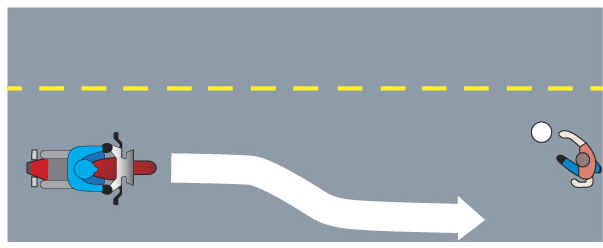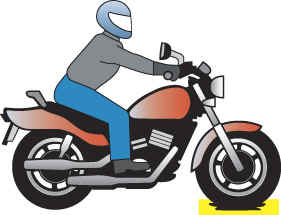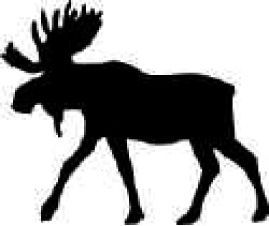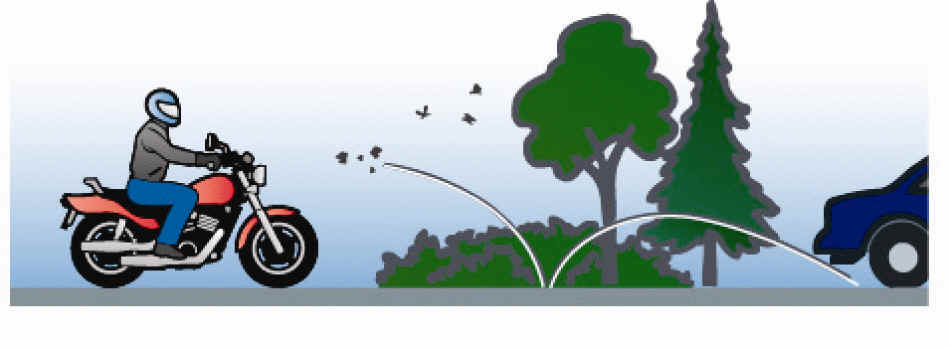| If you have to stop quickly do the following:
Weight shifts forward when you brake, and the front brake is especially powerful. Use it well, but respect it. About 70 percent of effective braking capacity is in the front brake. Weight shift can cause the braking force to increase to nearly 100 percent with threshold braking on the front wheel. You need practice to know how hard you can brake without locking the wheels and skidding. | |
|
| ||
| If an object appears suddenly in your path, you may not be able to stop in time. The only way to avoid a crash might be to turn quickly or to swerve around it. A swerve is any sudden change in direction. Check your mirror(s), and if someone is close behind, try to keep moving so that you will not be hit from behind. Use the counter-steering method (refer to chapter four) to swerve around the obstacle. If braking is required, do so before or after but never while swerving. Remember that a sudden change in throttle use can also cause a loss of control. | ||
Riding over obstacles
- Sometimes a rider may have no choice but to ride over an object that is seen too late to steer around. In this type of situation, follow these basic rules.
- Brake before reaching to the object if possible.
- Maintain a relaxed but firm grip on the handlebars.
- Keep as straight a course as possible.
- Stand slightly on the foot pegs.
- Shift your weight back.
- Accelerate slightly as the front wheel reaches the object.
- After going over the object, resume your normal seating position and speed.
- After a hard impact, pull off the road and check the tires and rims for damage before riding any further.

If a tire blows out, you will need to react quickly to keep balanced. A tire blowout is not always heard, but a rider should be able to detect a flat tire by the way the motorcycle reacts. A front tire blowout is more difficult to control since it affects steering. If the front wheel goes flat, the steering will feel heavy. If the rear tire goes flat, the back of the bike will tend to sway from side to side.
| ||
|
| ||
| If the front tire blows, hold the handlebars firmly and try to steer straight. Shift your weight to the rear of the bike. Do not brake. Ease off the throttle. When you have slowed enough, move off the travelled portion of the roadway and use the rear brake to come to a stop.
| ||
|
| ||
| If the rear tire blows, maintain your position on the bike. Do not brake. Ease off the throttle instead. When you have slowed enough, move off the travelled portion of the road and use the front brake carefully to come to a stop. | ||
Animals are unpredictable. If an animal is near the road, be ready to take evasive action or stop if necessary. Try to do everything possible to avoid hitting an animal. If you have no other choice, remember that hitting something small is less dangerous than hitting something much larger, like a vehicle. Motorcycles seem to attract dogs. If a dog chases your motorcycle, you should slow down, and downshift. Then, as the dog approaches, accelerate away. Do not attempt to kick at the dog since this may affect your ability to keep control of the motorcycle. | |||
|
| When on a highway, a rider should use extra caution at dusk and dawn when larger animals are more active. | ||
|
A motorcycle rider may be struck by insects, stones or debris thrown up by other vehicles. If you are not wearing any face protection, this can cause obscured vision, severe pain and temporary vision loss. If wearing face protection, it may get smeared or cracked, making it difficult to see. Whatever happens, concentrate on controlling the bike and staying on the road. When it is safe, pull off the travelled portion of the road and fix the problem. Never try to fix the problem while moving in traffic. A motorcycle rider should always have good eye and face protection. | |||
|
| |||
| A motorcycle rider should practice preventive maintenance to avoid mechanical emergencies. Most mechanical problems can be avoided by routine maintenance. A stuck throttle requires quick thinking.
A “wobble” occurs when the front wheel and handlebars suddenly start to shake from side to side. Typical causes of a wobble are:
| ||
- Do not attempt to use your brakes.
- Gradually close the throttle.
- Wait until the motorcycle has slowed down sufficiently, at which time the wobble will disappear. The brakes may now be applied as required.
- Pull off the travelled portion of the road as soon as possible.
- Determine if the problem can be corrected or not. If this is not possible, proceed at a reduced speed and have the motorcycle checked by a qualified person.
TQ to Government of Alberta





No comments:
Post a Comment